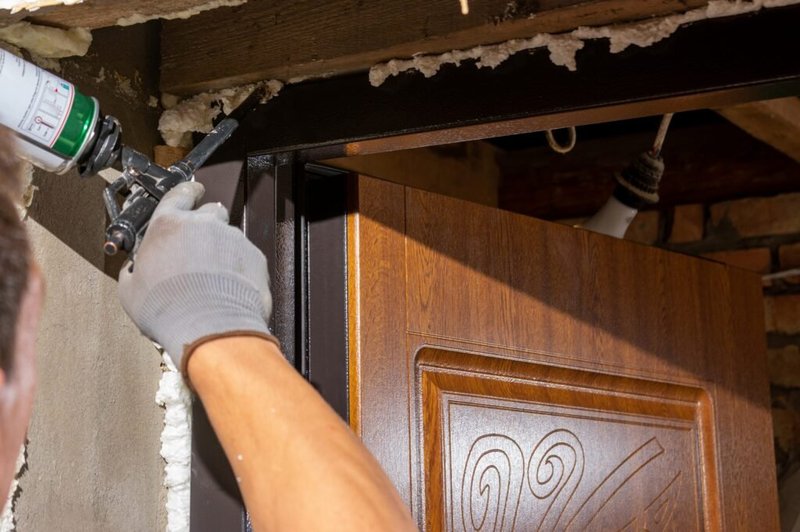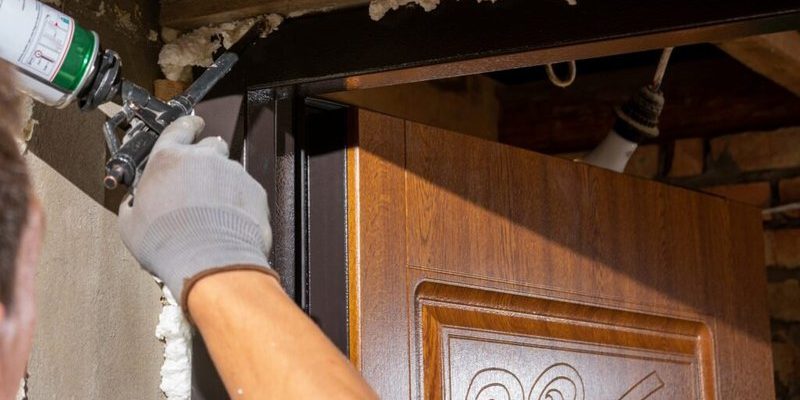
Honestly, this is one of those things that can make your house feel less cozy than it should, especially in the middle of winter. It doesn’t matter if you’ve got a classic wooden Therma-Tru entry door or a modern fiberglass JELD-WEN model—the symptoms and the headaches are basically the same. You shut the door, but the cold air just won’t stay outside. So, why does this happen? Let’s break it down step by step.
What Causes an Exterior Door to Leak Air?
Here’s the thing: exterior doors are supposed to create a barrier between your comfy living room and the wild, unpredictable outdoors. But if your door has an *improper seal*, it’s a bit like leaving your window open a crack. Even when the door feels “closed tightly,” tiny gaps can let air slip through. That’s what creates drafts and defeats your heater or air conditioner.
The main culprit is usually worn-out weatherstripping. Think of weatherstripping as the soft, compressible material running along the edges of your door frame. Over time, it gets squished, torn, or simply stops springing back like it should. Once that happens, air finds an easy path inside—even if your door is locked up tight.
But that’s not all. Sometimes, the door frame itself isn’t perfectly straight. Wood can warp, especially with swings in temperature and humidity. Even a small bend in the frame or threshold can throw the whole seal out of sync. So, air leaks can happen not only because of the material around your door but because of the structure holding it in place, too.
How Can an Improper Seal Happen?
You might be wondering: if your door closed fine last year, why is it leaking air now? A lot can change without you noticing. For starters, weatherstripping wears out *gradually*. You won’t see it crumbling overnight, but those small tears or flat spots build up and create gaps—especially in high-traffic spots where doors are opened and closed a lot.
Another sneaky cause is settling. Houses don’t stay perfectly still. They settle and shift, which can ever-so-slightly move door frames out of square. This movement pulls your door away from the weatherstripping, and suddenly, the seal isn’t so tight. Sometimes the door latch or hinges loosen, too, making the fit even worse.
And let’s not forget DIY improvements that backfire. Swapping out a door, changing hardware, or even painting the edges can throw off the alignment. If the door isn’t rehung or adjusted properly, the seal just won’t match up anymore. It’s a good reminder that “close enough” doesn’t always cut it when it comes to keeping air out.
How to Check If Your Exterior Door Is Sealed Properly
Before blaming your door, it helps to get hands-on and check for an improper seal. Here’s a simple test you can do with household items:
- Light Test: Wait until it’s dark, turn off the lights inside, and shine a flashlight all around the edges of your closed door. If you see light peeking through, air can sneak in, too.
- Palm Test: Hold your hand around the door frame, especially on a breezy day. Feel for moving air or temperature changes. Even a faint draft means the seal is compromised.
- Paper Test: Shut the door on a piece of paper so it straddles the seal. Try pulling it out. If it slides easily or doesn’t catch at all, your weatherstripping probably isn’t sealing well.
If your door fails any of these tests, it’s a sure sign the seal isn’t doing its job. Keep in mind that exterior doors—no matter if they’re from Pella, Masonite, or any brand—work the same way in this respect.
Common Places Where Air Leaks Around Doors
Even with a “tight” door, air leaks have favorite places to escape. Knowing where to look is half the battle.
- Bottom Sweep: This rubber or bristle strip sits along the door’s bottom edge. If it’s cracked, missing, or installed wrong, cold air will gush under the door.
- Side Weatherstripping: The vertical strips can come loose or flatten over time—especially on the side with the latch that takes the most pressure.
- Top Frame: This area is easy to ignore, but if the door sags or the frame warps, you’ll get a gap up high.
- Threshold: Sometimes the threshold (the raised piece you step over) isn’t flush with the door, or the gasket underneath wears out. That’s another sneaky entry point for drafts.
Pro tip: If you’re using a smart door lock or adding extra hardware, double-check that the new setup doesn’t disrupt the seal anywhere around the door.
How to Fix an Improper Door Seal
Once you know where air is leaking, fixing the improper seal can be a simple weekend project. Most solutions don’t require special skills—just patience and a few basic tools.
- Replace Weatherstripping: Take off the old material and bring it to the hardware store to match the size and style. Peel and stick the new strip or tack it into place on the frame.
- Install a New Door Sweep: Unscrew the old sweep, slide in a new one, and trim it so it fits snugly without making the door hard to close.
- Adjust the Threshold: Many thresholds have screws you can turn to raise or lower them. Tighten things up until the bottom of the door lightly compresses the threshold when closed.
- Tighten Hinges and Latch Plates: Use a screwdriver to firm up any loose hardware. This can help the door fit better into the frame and improve the seal.
If your entire door or frame is warped, you might need a pro to re-square things. But most air leaks come from smaller issues that you can handle yourself with a little troubleshooting.
Comparing Different Door Types and Their Sealing Challenges
You might be curious whether some doors leak air more than others. The answer? It depends on the materials and design, not just the brand. Let me explain.
- Wooden Doors: These are beautiful but can swell, shrink, or warp with changes in humidity. That movement can break the seal, so they need more regular touch-ups.
- Fiberglass and Steel Doors: These are usually more stable, but they depend on tight-fitting frames and weatherstripping. If the seal is off, even the fanciest door will leak air.
- Prehung vs. Retrofit Doors: Prehung doors (sold in their own frame) tend to seal better out of the box, but only if installed perfectly square. Older retrofit doors (just the slab, reused in an old frame) might not match up as well, which can mean more leaks.
So, no matter if you’re working with a universal style or a specific brand’s remote entry system—like Schlage, Kwikset, or Yale—the basics of sealing don’t really change.
When Should You Call a Professional?
Not every leaky door needs a contractor, but sometimes the problem is just too big for a DIY fix. For example, if you’ve tried weatherstripping and adjusting everything, but still feel drafts, the frame could be shifted from settling or water damage.
Signs it’s time to call for help:
- Visible gaps remain after repairs.
- The door is hard to open, close, or lock properly.
- Threshold or frame is clearly warped or rotting.
- Major condensation, moisture, or even pest issues around the door.
A pro can check whether you need a new door, a new frame, or just a more advanced sealing technique. If you have a high-end smart door lock or wireless remote entry system, a certified installer can make sure everything’s secure and air-tight—without messing up your code or reset settings.
Preventing Future Air Leaks: Simple Maintenance Tips
Here’s the good news: once you fix an improper seal, you can keep your exterior door air-tight with just a bit of routine care. Make it part of your seasonal home checklist.
- Inspect weatherstripping twice a year. Look for cracks, flattening, or peeling, especially after heavy use or wild temperature swings.
- Check for sagging or sticking doors. If your door starts catching or feels loose in the frame, adjust the hinges right away before bigger gaps form.
- Clean door sweeps and thresholds. Dirt and debris can stop seals from sitting flush, so keep these areas clear.
- Repaint or reseal wooden doors. This helps keep moisture (and warping) at bay, which protects the fit and keeps air leaks away.
A little effort goes a long way toward a cozier, more energy-efficient home—no expensive smart remote or sync code needed.
Every home gets a little drafty sometimes, but an air-leaking door isn’t something you have to just live with. With the right troubleshooting steps and a few simple tools, you’ll restore that “just-right” seal and keep the weather exactly where it belongs: out.
Honestly, fixing an exterior door that leaks air—even when it seems tightly closed—usually comes down to restoring a proper seal. Once you know what to look for, you can tackle the problem quickly and avoid another season of drafts, noisy air leaks, or wasted energy. Whether your front entry is high-tech or classic, a snug, well-sealed door makes all the difference for your comfort and peace of mind.
